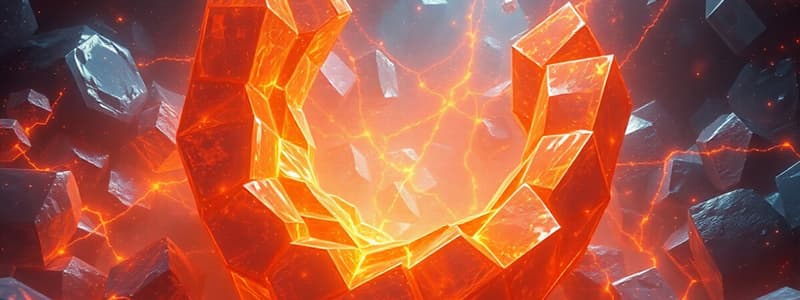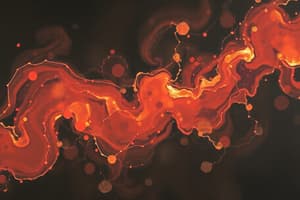Podcast
Questions and Answers
Based on the data provided, which substance requires the least energy to convert from a solid to a liquid state?
Based on the data provided, which substance requires the least energy to convert from a solid to a liquid state?
- Lead (Pb)
- Copper (Cu)
- Water (H2O)
- Oxygen (O2) (correct)
Which of the following statements accurately describes the specific latent heat of vaporization?
Which of the following statements accurately describes the specific latent heat of vaporization?
- It is the energy released when 1 kg of a gas condenses into 1 kg of liquid at the same temperature.
- It is the energy required to convert 1 kg of a liquid to 1 kg of gas at the same temperature. (correct)
- It is the energy needed to convert 1 kg of a solid directly into a gaseous state.
- It is the energy needed to raise the temperature of 1 kg of a substance by 1 degree Celsius.
Why does $L_F$ have a lower value than $L_V$?
Why does $L_F$ have a lower value than $L_V$?
- The energy required to break intermolecular bonds to transition from solid to liquid is less than that to transition from liquid to gas. (correct)
- The energy required to break intermolecular bonds to transition from solid to liquid is more than that to transition from liquid to gas.
- Latent heat of vapourization occurs at the triple point.
- Latent heat of fusion is measured at higher temperatures.
At the triple point of a substance:
At the triple point of a substance:
What is the significance of the positive slope of the liquid-gas phase boundary in the water ($H_2O$) phase diagram?
What is the significance of the positive slope of the liquid-gas phase boundary in the water ($H_2O$) phase diagram?
Under what condition does visible evaporation occur throughout the bulk of a liquid?
Under what condition does visible evaporation occur throughout the bulk of a liquid?
Which statement accurately describes the relationship between temperature and phase changes, according to the information provided?
Which statement accurately describes the relationship between temperature and phase changes, according to the information provided?
What distinguishes the latent heat of vaporization from the latent heat of fusion for a given substance?
What distinguishes the latent heat of vaporization from the latent heat of fusion for a given substance?
If a beaker of ice is heated at a constant rate, what happens to the temperature while the ice is melting?
If a beaker of ice is heated at a constant rate, what happens to the temperature while the ice is melting?
A closed container holds water at its boiling point. What describes the equilibrium between the liquid and vapor phases?
A closed container holds water at its boiling point. What describes the equilibrium between the liquid and vapor phases?
What occurs at the atomic and molecular level within solids?
What occurs at the atomic and molecular level within solids?
What happens to the vibration of atoms in a crystal lattice as temperature increases?
What happens to the vibration of atoms in a crystal lattice as temperature increases?
What is the term used to describe the breaking of lattice bonds between adjacent atoms or molecules in a solid due to vigorous vibrations caused by increasing temperature?
What is the term used to describe the breaking of lattice bonds between adjacent atoms or molecules in a solid due to vigorous vibrations caused by increasing temperature?
Why do liquids evaporate?
Why do liquids evaporate?
What is vapor pressure (VP)?
What is vapor pressure (VP)?
What happens to vapor pressure (VP) of a liquid as temperature increases?
What happens to vapor pressure (VP) of a liquid as temperature increases?
What characterizes the arrangement of molecules in a liquid, compared to a solid?
What characterizes the arrangement of molecules in a liquid, compared to a solid?
What is the condition at equilibrium regarding evaporation and condensation?
What is the condition at equilibrium regarding evaporation and condensation?
Flashcards
States of Matter
States of Matter
The different physical forms that matter can take, most commonly solid, liquid, and gas.
Solid
Solid
A state of matter with a definite shape and volume, characterized by a highly ordered arrangement of atoms or molecules in a crystal lattice.
Crystal Lattice
Crystal Lattice
The organized arrangement of atoms or molecules in a solid, repeating in every direction.
Thermal Expansion
Thermal Expansion
Signup and view all the flashcards
Melting
Melting
Signup and view all the flashcards
Liquids
Liquids
Signup and view all the flashcards
Evaporation
Evaporation
Signup and view all the flashcards
Vapor Pressure (VP)
Vapor Pressure (VP)
Signup and view all the flashcards
Boiling Point (BP)
Boiling Point (BP)
Signup and view all the flashcards
Boiling
Boiling
Signup and view all the flashcards
Liquid-Vapor Equilibrium
Liquid-Vapor Equilibrium
Signup and view all the flashcards
Latent Heat of Fusion
Latent Heat of Fusion
Signup and view all the flashcards
Latent Heat of Vaporization
Latent Heat of Vaporization
Signup and view all the flashcards
Specific Latent Heat of Fusion (Lf)
Specific Latent Heat of Fusion (Lf)
Signup and view all the flashcards
Specific Latent Heat of Vaporization (Lv)
Specific Latent Heat of Vaporization (Lv)
Signup and view all the flashcards
Phase Diagram
Phase Diagram
Signup and view all the flashcards
Triple Point
Triple Point
Signup and view all the flashcards
Liquid-Gas Phase Boundary
Liquid-Gas Phase Boundary
Signup and view all the flashcards
Study Notes
States of Matter
- The lecture will cover states of matter
- Key topics will be temperature change mechanisms, the 5 phases of matter, differentiating between phases and latent heat
Phases of Matter
- The three most commonly known states of matter are solids, liquids, and gases
- Adding energy changes the phase of a substance
- Alternatively subtracting heat will change the phase of a substance
Solids
- At the atomic and molecular scale, solids are highly ordered and have organised structures with crystal properties
- Even powders are made of millions of micro-crystals
- The atoms in a solid occupy lattice points arranged periodically in every direction in a crystal
- Atoms in the crystal lattice vibrate about their equilibrium lattice positions
- As temperature increases, the amplitude and frequency of vibration also increases, leading to thermal expansion
- If the temperature continues to rise, the vibrations become so strong that the lattice breaks apart, known as melting
- Solids melt and become liquid
Liquids
- Particles in a liquid are further apart than in a solid, but are still able to attract each other
- Liquids are not arranged in a regular pattern and have no inherent shape
- Liquids can be moulded into any form by placing it in a container
- Liquid molecules are not rigidly bound, allowing fast movement
- Some molecules have enough kinetic energy to escape from the bulk liquid; process called evaporation
- Rate of evaporation increases with temperature
- Molecules evaporating from a liquid surface generate Vapor Pressure (VP)
- At Equilibrium, the number of molecules evaporating equals the number of vapor molecules re-entering the liquid
- Vapor Pressure increases as temperature increases
- The temperature at which the VP equals atmospheric pressure (Patm) is known as the Boiling Point (BP)
- At the Boiling Point, visible evaporation occurs throughout the bulk of the liquid
- The Boiling Point is the only temperature at which a liquid and its vapor can coexist in equilibrium for a given pressure
Gases
- Heating a liquid gives particles more energy, causing them to move faster
- The atoms can escape from the liquids surface becoming a gas
- The particles in gas move around very fast and cannot attract each other
Latent Heats
- Latent heat of fusion is 6kJ/mol (3.3 x 10^5 J/kg) - energy to change from solid to liquid at the same temperature
- Latent heat of vaporisation is 41kJ/mol (22.6 x 10^5 J/kg)- the energy to change from a liquid to a gas at the same temperature
- The energy required to convert 1kg of solid to 1kg of liquid at the same temperature is the Specific Latent Heat of Fusion (Lf)
- The energy required to convert 1kg of liquid to 1kg of gas at the same temperature is the Specific Latent Heat of Vaporisation (Lv)
- In almost all cases, Lf is much less than Lv
- Some mammals use Lv to cool themselves by evaporating liquids on the skin surface
- In snowy conditions, birds require more twice as much heat to melt snow than heat their body
Phase Diagrams
- Temperature at which phase change occurs varies with the absolute pressure
- The Triple Point on the phase diagram signifies the only conditions under which all three phases (solid, liquid, and gas) can exist simultaneously
- It is possible to boil water at a temp less than 100°C if the gas pressure above the liquid surface is lowered
Phase Diagram CO2
- The triple point of CO2 is at temp = -56.6°C and pressure = 5.1 atm
- Liquid CO2 can never exist at standard atmospheric pressure
- Reducing the pressure sufficiently can cause to skip the liquid phase completely and go straight from solid to gas phase, called Sublimation
- Freeze-drying is also possible by the same principle
Other States of Matter
- There are two other Phases/States of matter and they occupy opposite ends of the energy/heat spectrum
- Removing almost all the heat energy from a small group of inert atoms leads to the Quantum Mechanical state
- Bose-Einstein Condensate occurs at micro-Kelvin Temperatures, where atoms occupy identical ground states
- Plasma requires so much energy that all electrons are ionized off the atom resulting the final state of matter
- A plasma is a rarified gaseous soup of positive and negative ions, highly reactive, which is used settings for disinfection
- Aurora Borealis/Australis is an example of plasma activity
Studying That Suits You
Use AI to generate personalized quizzes and flashcards to suit your learning preferences.




